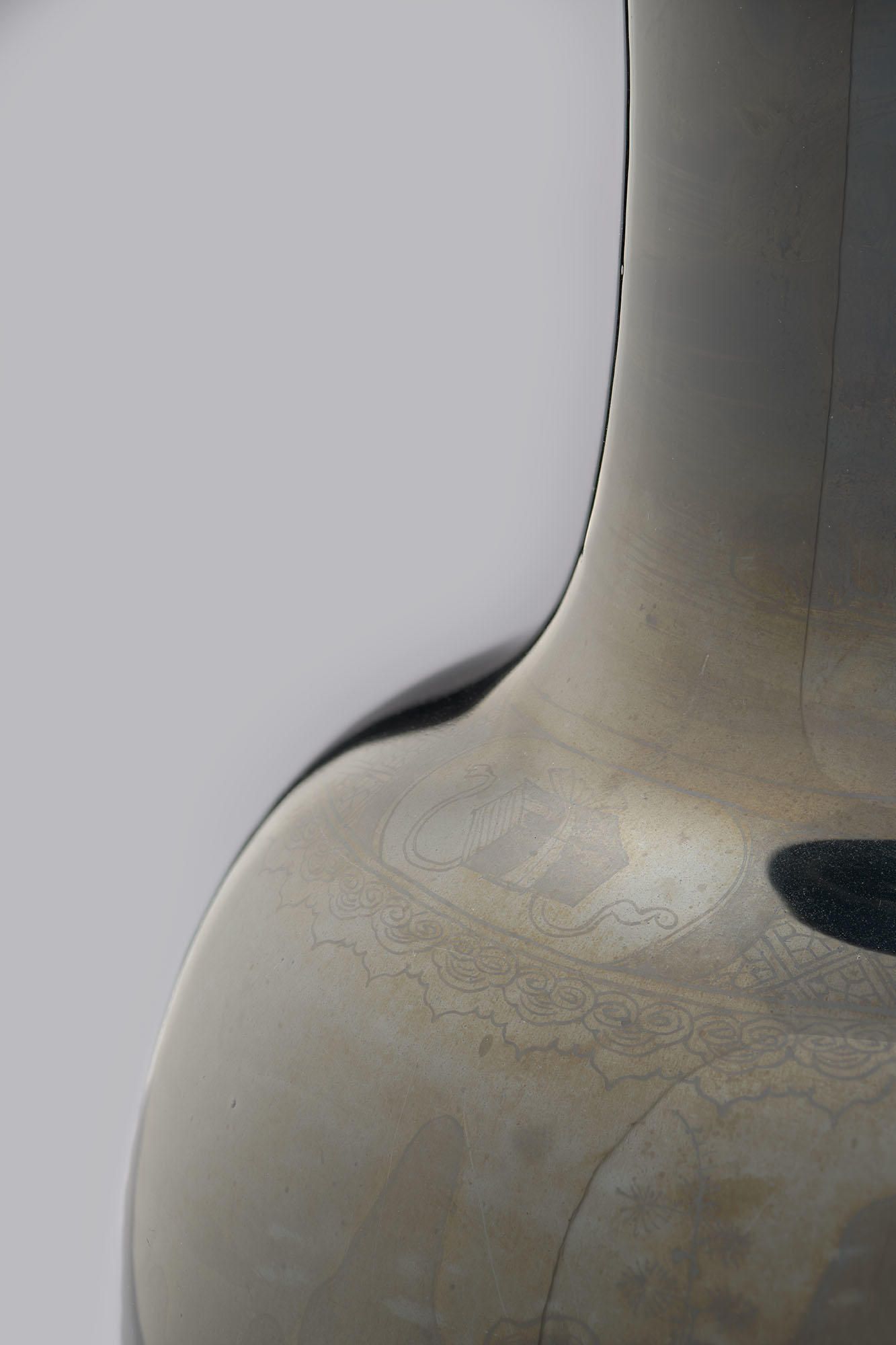Isabella Stewart Gardner placed a shiny black vase high on top of the cabinet in the Yellow Room. From a distance, the vessel looks as if it is only covered with a plain black glaze. Indeed, Isabella’s first museum director, Morris Carter, catalogued it in 1935 simply as a “Chinese black porcelain vase.”1
Hidden Figures
However, upon close inspection and under certain angles of light, the outlines of landscape, architectural structures, and boats on a river become visible. There are textured hills depicted in a manner that recalls ink painting, as well as several figures that look like male scholars. It is difficult to see these details with the naked eye and even more challenging to photograph. In order to capture these faint traces of overglaze decoration, the Gardner Museum’s photographer Amanda Guerra, constructed a black-out box with one white wall. She directed her light onto the white wall and bounced the reflected light back onto the vase, rather than directly lighting its surface.
In the Qing dynasty (1644–1911), a reflective black glaze, called wujin you 乌金釉 in Mandarin Chinese, was popular.2 Its English name, “mirror-black glaze,” likely comes from letters by the French Jesuit priest François-Xavier d’Entrecolles (1664–1741) who wrote about the glaze when he was living and working in China in the 1700s.3 Some mirror-black vessels were produced as plain monochrome wares, while others are decorated with gold over the glaze. Some scholars have linked the development of gold-decorated mirror-black ceramics to the popularity in both Europe and East Asia of black lacquer decorated with gold.4
GOLD: “X”RF MARKS THE SPOT
The Gardner vase was likely once decorated with overglaze gold. Although overglaze gold decoration is fired onto the glazed surface of the vessel, it is fired at a low temperature leaving it susceptible to wear from handling, use, or previous cleanings. Jessica Chloros, Objects Conservator at the Gardner Museum, analyzed the surface of the vessel using X-ray fluorescence spectroscopy, or XRF for short. XRF is a quick, non-destructive analytical technique that uses the interaction of X-rays with a material to determine which elements are present. XRF essentially gives an elemental fingerprint of the analyzed area. For the vase, XRF analysis showed that on the plain black glazed surface, the elements cobalt, manganese, and iron were present, all key elements in mirror-black glaze.5 Additionally, analysis of a small area near one of the thatched roofs where there appeared to be remnants of metallic decoration revealed the presence of gold and copper. This was an exciting scientific confirmation that the vase was previously decorated with gold.

Isabella Stewart Gardner Museum, Boston (C1s14). See it in the Yellow Room
Chinese, Vase, 19th century. Glazed ceramic with traces of overglaze gold decoration, 45.7 x 18.1 cm (18 x 7 1/8 in.)
Today, it is difficult to see the traces of decoration on the Gardner vase, but it depicts a landscape decoration similar to what can be seen in gold on a vase sold at Sotheby’s in 2021. Other examples of mirror-black glazed ceramics with traces of overglaze gold decoration can be found just across the river in Cambridge. There are several vessels with just the outlines of decoration dated to the 1700s and 1800s at the Harvard Art Museums (1950.83.21, 28, 32, 33, 34).
It is possible that a previous owner of Isabella’s vase, or a dealer preparing the work for sale, cleaned the Gardner vase of most visible traces of gold before Isabella purchased it. While we do not know where or when Isabella acquired this vessel, the vase may be in a 1903 photograph on the shadowy right side of the top shelf next to the fireplace in the gallery then installed as the Chinese Room. Isabella re-installed that gallery as the Early Italian Room in 1914.
The vase was definitely in the collection by 1915, when it was photographed in the Yellow Room. Though Isabella likely never knew the vase was decorated with gold, it feels fated that she ultimately placed it in the golden setting of her Yellow Room.
You May Also Like

Read More on the Blog
Technical Study of an 11th-12th century Guanyin Sculpture

Read More on the Blog
Making Reproductions of Two Hanging Scroll Paintings at the Gardner Museum

Explore the Museum
The Yellow Room
1Gilbert Wendel Longstreet and Morris Carter. General Catalogue, Isabella Stewart Gardner Museum (Boston: Isabella Stewart Gardner Museum, 1935, second printing 1964) 21.
2Nigel Wood. Chinese Glazes, Their Origins, Chemistry, and Recreation (Philadelphia: University of Pennsylvania Press, 2011) 156, 265.
3Linda Rosenfeld Shulsky. “Famille Noire and Mirror-Black: The European Taste for Black-Ground Ceramics of the Kangxi Period (1662-1722) and their Relationship to Lacquer,” in Monica Kopplin, ed., Maureen Cassidy-Geiger and Letitia Roberts, trans. Schwartz Porcelain. The Lacquer Craze and its Impact on European Porcelain (Munich: Hirmer Verlag, 2004) 31–36. See pages 32–33.
4Shulsky (2004) 34. Wood (2011) 265. Wood reconstructed this glaze from a recipe from the ceramic production center Jingdezhen in China described by Georges Vogt, published in 1900.
5Wood (2011) 265. Wood reconstructed this glaze from a recipe from the ceramic production center Jingdezhen in China described by Georges Vogt, published in 1900.










